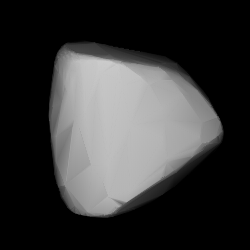103 Hera
 3D convex shape model of 103 Hera | |
| Discovery | |
|---|---|
| Discovered by | James Craig Watson[1] |
| Discovery date | 7 September 1868[1] |
| Designations | |
| (103) Hera | |
| Pronunciation | /ˈhɪərə/[2] |
Named after | Hera |
| A868 RA, 1927 CV 1950 CM | |
| Main belt | |
| Orbital characteristics[3] | |
| Epoch 31 July 2016 (JD 2457600.5)[1] | |
| Uncertainty parameter 0 | |
| Observation arc | 144.99 yr (52958 d) |
| Aphelion | 2.92042 AU (436.889 Gm)[1] |
| Perihelion | 2.48175 AU (371.265 Gm)[1] |
| 2.70109 AU (404.077 Gm)[1] | |
| Eccentricity | 0.0812034[1] |
| 4.44 yr (1621.5 d)[1] | |
Average orbital speed | 18.09 km/s |
| 133.341° | |
| 0° 13m 19.279s / day | |
| Inclination | 5.41957° |
| 136.186° | |
| 188.361° | |
| Earth MOID | 1.46898 AU (219.756 Gm) |
| Jupiter MOID | 2.32392 AU (347.653 Gm) |
| TJupiter | 3.356 |
| Physical characteristics | |
| Dimensions | 91.20±5.6 km |
| Mass | 7.9×1017 kg |
Equatorial surface gravity | 0.0255 m/s² |
Equatorial escape velocity | 0.0482 km/s |
| 23.740 h (0.9892 d)[3] 0.9892 d[4] | |
| 0.1833±0.025 | |
| Temperature | ~170 K |
| S[5] | |
| 7.66 | |
Hera (minor planet designation: 103 Hera) is a moderately large main-belt asteroid with an orbital period of 4.44 years. It was discovered by Canadian-American astronomer James Craig Watson on September 7, 1868,[6] and named after Hera, queen and fifth in power of the Olympian gods in Greek mythology. This is a stony S-type asteroid[5] with a silicate surface composition.
Photometric observations made in 2010 at the Organ Mesa Observatory at Las Cruces, New Mexico, and the Hunters Hill Observatory at Ngunnawal, Australian Capital Territory, give a synodic rotation period of 23.740±0.001 h. The bimodal light curve shows a maximum brightness variation of 0.45 ± 0.03 in magnitude.[4]
Measurements made with the IRAS observatory give a diameter of 91.58±4.14 km and a geometric albedo of 0.19±0.02. By comparison, the MIPS photometer on the Spitzer Space Telescope gives a diameter of 88.30±8.51 km and a geometric albedo of 0.20±0.04. When the asteroid was observed occulting a star, the chords showed a diameter of 89.1±1.1 km.[7]
References[edit]
- ^ a b c d e f g h JPL Small-Body Database Browser, JPL, retrieved 30 October 2020
- ^ "Hera". Oxford English Dictionary (Online ed.). Oxford University Press. (Subscription or participating institution membership required.)
- ^ a b Yeomans, Donald K., "103 Hera", JPL Small-Body Database Browser, NASA Jet Propulsion Laboratory, retrieved 12 May 2016.
- ^ a b Pilcher, Frederick (January 2011), "Rotation Period Determination for 103 Hera", The Minor Planet Bulletin, 38 (1): 32, Bibcode:2011MPBu...38...32P.
- ^ a b DeMeo, Francesca E.; et al. (2011), "An extension of the Bus asteroid taxonomy into the near-infrared" (PDF), Icarus, 202 (1): 160–180, Bibcode:2009Icar..202..160D, doi:10.1016/j.icarus.2009.02.005, archived from the original (PDF) on 17 March 2014, retrieved 22 March 2013. See appendix A.
- ^ "Numbered Minor Planets 1–5000", Discovery Circumstances, IAU Minor Planet center, retrieved 7 April 2013.
- ^ Ryan, Erin Lee; et al. (April 2012), "The Kilometer-Sized Main Belt Asteroid Population as Revealed by Spitzer", arXiv:1204.1116 [astro-ph.EP]
External links[edit]
- 103 Hera at AstDyS-2, Asteroids—Dynamic Site
- 103 Hera at the JPL Small-Body Database
